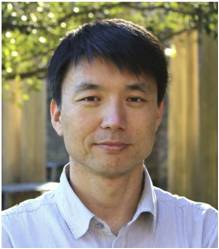报告题目:Nanostructured Earth-Abundant Electrocatalysts for Water
Splitting
报告人:赵川,副教授,新南威尔士大学
主持人:申燕
报告时间:2017年4月24日上午9:00-10:00
地 点:武汉光电国家实验室(筹)A302
报告人简介: Prof Chuan Zhao is currently at the School of Chemistry at The
University of New South Wales (UNSW), based in Sydney, Australia. Prof Chuan
Zhao is currently the Chairman of the Royal Australian Chemical Institute (RACI)
Electrochemistry Division, and also the Chairman of the 4th Asia-Pacific
Conference on Ionic Liquids and Green Processes / 6th Australasian Symposium on
Ionic Liquids. He received his PhD in 2002 with an excellence award from
Northwest University. He then completed 4 years of postdoctoral research at the
University of Oldenburg. In 2006, he moved to Monash University as a senior
research fellow. He started his independent research career at UNSW as a
Lecturer in Oct 2010. He also holds a prestigious Australian Research Fellowship
from Australian Research Council. Prof Chuan Zhao is interested in discovering
novel electroactive nanomaterials and their implications to electrochemical
energy storage and conversion, and biomedicine applications. He is also
interested in ionic liquids chemistry and its applications for electrochemical
energy systems. His group is exploring these new electrode and electrolyte
materials for electrocatalysis and applications such as water splitting, fuel
cells, CO2 reduction, lithium-air batteries, and gas sensors.The hundreds of
papers were published in the high level publications in recent years, including
Nat. Comm., PNAS, J. Am. Chem. Soc., Angew. Chem. Int. Ed., as well as many hot
papers and highly cited papers.

报告摘要:The increasing demands for clean energy have triggered tremendous
research interests on electrochemical energy conversion and storage systems with
minimum environmental impact. Electrolytic water splitting holds the promise for
global scale storage of renewable energy, e.g., solar and wind in the form of
hydrogen fuel, enabling the continuous usage of these diffusive and intermittent
energy sources when used together with fuel cells. Nevertheless, the widespread
application of water splitting technology has been severely constrained by the
use of precious metal catalysts, such as oxides of ruthenium and iridium for the
anodic oxygen evolution reaction (OER), and platinum for the cathodic hydrogen
evolution reaction (HER). This presentation concerns our recent progress in
developing nanoporous, non-precious metal-based and carbon-based water splitting
catalysts, as well as our strategies for enhancing the efficiency of these
catalysts to a level comparable to that of precious metal catalysts.